Why Is Understanding Our Dog's Body language So Vital?
Debbie Martin, Fear Free
 Licensed Veterinary Tech and Certified Professional Dog Trainer Debbie Martin is here to help us decode our pet's body language. She knows just about everything about dog behavior and how to read your own dog's body language and states there are some common signs of distress or anxiety that people miss. This is part of our Fear Free Expert Series.
Licensed Veterinary Tech and Certified Professional Dog Trainer Debbie Martin is here to help us decode our pet's body language. She knows just about everything about dog behavior and how to read your own dog's body language and states there are some common signs of distress or anxiety that people miss. This is part of our Fear Free Expert Series.
Many people are oblivious to actually understanding what our pets are saying with their behavior. Animals can't just yap out when they're feeling hungry or upset, but they do show it with their bodies. Unfortunately most of us don't know how to interpret that.
Why is it important to understand your pet's body language?
Debbie explains that its really important that owners can read their pet's body language, whether it be a dog or a cat, because its their main mode of communication to humans. Animals communicate in a variety of different ways through vocalizations as well as smell or scent within their species. But their main mode of communication for people is really going to be body language. These are things that we can pick up on as pet parents and advocates for our pets so we can recognize when they're feeling relaxed and happy about something or when they might be a little bit nervous or anxious.
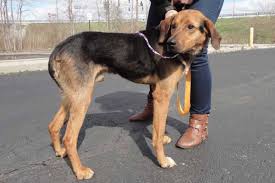 What are some common signs of distress and anxiety?
What are some common signs of distress and anxiety?
There are obvious signs that are going to happen when an animal is trying to get away from a situation. It could be that their tails are tucked really tight underneath them, they're frozen with fear, they're trembling or their ears are back. Those are very obvious signs that animal is distressed or nervous or anxious, but there can be very subtle signs that lead up to that as well. It's important that we're aware of these signs so that we can perhaps change the environment or the interaction that's happening so our animal doesn't become overly distressed.
Some of the subtle signs are things like licking their lips, avoiding eye contact, maybe turning their head away or moving away slightly. It could be panting when they're not hot or being active. Sometimes we'll see dogs do things like the "wet dog shake" when they are playing roughly with another dog. They may all of a sudden stop and shake off even though they're not wet. This is kind of a stress reliever for them. So these can be kind of subtle things that are happening that could just say our dogs a little bit nervous or anxious or it could be higher arousal.
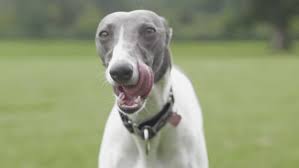 What's really important to realize is that body language tells part of the story. But the other part is context. Looking at the context of when it's happening. So for example, if a stranger approaches your dog and the dog looks away, licks his lips and maybe does a wet dog shake and starts to turn away from that person, your dog is probably saying, "Hey I'm not quite comfortable interacting with this person right now." And we shouldn't force the issue.
What's really important to realize is that body language tells part of the story. But the other part is context. Looking at the context of when it's happening. So for example, if a stranger approaches your dog and the dog looks away, licks his lips and maybe does a wet dog shake and starts to turn away from that person, your dog is probably saying, "Hey I'm not quite comfortable interacting with this person right now." And we shouldn't force the issue.
So does a wagging tail always mean that a dog is happy and approachable?
Not always. It depends how the tail wags, according to Debbie. Then again there is the context. Is it in the natural position that that dog will carry its tail? This can get tricky because dog tails come in a variety different shapes and sizes and carriage. Some dogs carry them naturally really high over their back and some don't even have tails, which make it even more challenging. But others are going to have just kind of normal tail carriage.
You need to be able to recognize your own dog's body language, like where their tail is when you come home and they're happy to see you. What does that look like? It should be kind of wag back and forth. That's a fairly neutral position and its not way up high over their back, unless that's how your dog normally carries their tail. There are breeds of dogs that their tails curl up over their back and so it doesn't always apply depending on the breed or the combination of breeds that your dog has within them.
There is one thing that Debbie always sees people do that she wishes they would stop. She states that there's this misconception that we need to put our hand out for a strange dog to smell us so that they can kind of get to know us. However, dogs can smell us from a mile away. A dog can smell a human fingerprint on a pane of glass six weeks later. You don't need to put your hand out!
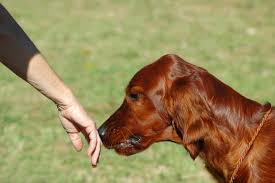 When you put your hand out, in dog language that is getting into their personal space maybe before they're ready. Debbie's biggest tip for people is to play hard to get even with dogs that seem interested in you. Act very nonchalant. Avoid eye contact. Turn sideways and let them approach you on their own terms instead of trying to be their friend right away. Because even the most well intentioned friendly person can put a dog off very quickly by getting into their face and trying to be their best friend immediately.
When you put your hand out, in dog language that is getting into their personal space maybe before they're ready. Debbie's biggest tip for people is to play hard to get even with dogs that seem interested in you. Act very nonchalant. Avoid eye contact. Turn sideways and let them approach you on their own terms instead of trying to be their friend right away. Because even the most well intentioned friendly person can put a dog off very quickly by getting into their face and trying to be their best friend immediately.
Just think if you were out walking and someone said hello to you. You would probably say it back and that would be fine. But if they ran up right into your face and tried to give you a little hug, you would be pretty overwhelmed. It's no different with dogs.
Check out the websites Fear Free Happy Homes and Fear Free Pets.
Listen and Explore the Fear Free Expert Series
My Big Fat Pet Makeover
Travis Brorsen, Animal Planet
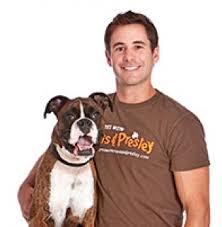 Animal Planet host Travis Brorsen begins a four-month weight loss and behavior modification journey with pet owners and their overweight animals. Is your pet tipping the scale? Don't take it personally. Over 60-percent of American pets are obese.
Animal Planet host Travis Brorsen begins a four-month weight loss and behavior modification journey with pet owners and their overweight animals. Is your pet tipping the scale? Don't take it personally. Over 60-percent of American pets are obese.
In the last ten years, the number of overweight cats and dogs has more than doubled. We love our pets and sometimes show our love by giving them treats or sharing our food with them. However, this can only cause problems in the future with obesity, which can lead to many issues such as respiratory problems or osteoarthritis, to name a few.
Pet expert and trainer Travis Brorsen is starting a brand new show on Animal Planet called My Big Fat Pet Makeover to help curb this problem.
My Big Fat Pet Makeover show is basically the biggest loser meets pet, with a little bit of animal behavior and training thrown in. Travis reiterates that it's really more about training the owners and getting them on board. When it comes down to it, the pet usually is the easy part but it's working on the owners. When it comes to telling an owner that their pet is overweight, talk about hitting a soft spot!
Travis notices that a lot of fat pets have fat owners. Believe it or not, they even had some of the owners on the first season of the My Big Fat Pet Makeover lose weight. One of them even lost 50 pounds. It's done by just lifestyle change.
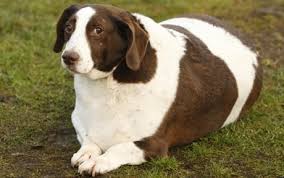 You can make a lot of small changes to help your pet lose weight, but you need to be able to stick with it and make it a routine. Just like human diets, we diet for a few weeks and then we fall back into our old habits. It's really about making a whole lifestyle change.
You can make a lot of small changes to help your pet lose weight, but you need to be able to stick with it and make it a routine. Just like human diets, we diet for a few weeks and then we fall back into our old habits. It's really about making a whole lifestyle change.
Some things you can do are adding vegetables to your pet's food as fillers. These include things like broccoli, apples and carrots. There are a lot of great vegetables you can put in your pet's food, as well as bananas and strawberries. There are many options to use so you can stop giving your pet all of your table food. You can make it a fun and enrichment process for both you and your pet. Just remember, don't add these vegetables in addition to their food, replace a small portion of their food with the vegetables. For example, pull away about 1/4 of their food and then replace that with 1/4 vegetables. You want to make sure it is a balance meal, so don't just give them vegetables. They still need their regular pet food.
In making the show, Travis says he didn't see any kind of similarities with the types of overweight pets. There wasn't a certain breed or a certain age group that was more overweight than any others.
 What he did find is that there were some owners who hadn't had a vet check for their pet in a really long time. Before they started working with any pet, they had to get them to a vet and get them cleared to make sure they were in a healthy place to lose weight.
What he did find is that there were some owners who hadn't had a vet check for their pet in a really long time. Before they started working with any pet, they had to get them to a vet and get them cleared to make sure they were in a healthy place to lose weight.
For dogs, it's really important for them to lose between three and five percent of their body weight per month to stay in a really safe zone. It's not the kind of thing where you can just go in and starve a pet to get them healthy. That's almost as bad as having them be obese.
It seems like there was a lot of miscommunication and a lot of owners that just weren't educated on how important health was for their pets. With education, they felt empowered to make some big changes. My Big Fat Pet Makeover, unlike the biggest loser, isn't a contest. What you win is extra years added to your dog's life.
There's nothing you win other than unconditional love and you can't put a dollar amount on that. The whole process is meant to build a bond and relationship between the owners and their pets as they go through this process.
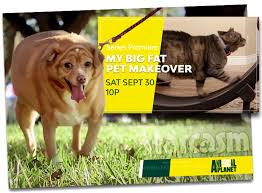 The show put together a complete health and wellness plan everything from daily exercise to the amount of food they should be feeding their pet when they should be feeding their pet for the contestants.
The show put together a complete health and wellness plan everything from daily exercise to the amount of food they should be feeding their pet when they should be feeding their pet for the contestants.
At home Travis has a 7-year-old white boxer rescue from the Oklahoma Boxer Rescue where he is from. Travis feels a lot of pressure to keep him in shape and does this with exercise and making sure he has the right calorie intake.
My Big Fat Pet Makeover, produced by Animal Planet, premiers Saturday September 30th at 10pm ET/PT.
Visit Website
9th Annual Get Your Licks on Route 66
Susan Sims, Fido Friendly Magazine
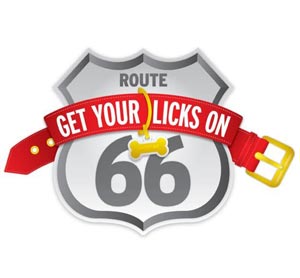 It's time again for the Ninth Annual Get Your Licks on Route 66 Adoption Tour. Miss Susan Sims is checking in from the road.
It's time again for the Ninth Annual Get Your Licks on Route 66 Adoption Tour. Miss Susan Sims is checking in from the road.
The Get Your Licks on Route 66 Adoption Tour is an annual cross-country pet adoption tour. They start in Los Angeles and go all the way to Chicago and work their way back. The tour is to help raise money for the shelters along the way and to raise awareness for the plight of these shelter animals. Their first 8 Get Your Licks on Route 66 Tours helped place over 9,000 pets into new forever homes. Petco Foundation is their presenting sponsor with Animal Radio being their media sponsor.
Today the tour takes them to Edmond, Oklahoma. Susan loves coming back through Oklahoma. She says you will find some of the nicest people you'll ever want to meet there. They have three shelter events in Oklahoma and the shelters are so delighted to have the tour come to them. Susan brings her giant spinning filled with prizes donated by their sponsors. Attendees then donate money to spin the wheel for those prizes and at the end of the day all of those donations go to the local shelter. It's a way for the tour to give back and make it fun for everybody.
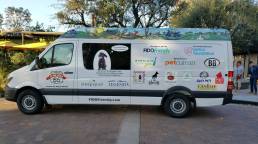 Tomorrow the Tour will be at the Woodland Hills Mall in Tulsa, Oklahoma. This is such a great place for an adoption event. They are usually located inside the mall by the escalators so the animals receive a lot of exposure.
Tomorrow the Tour will be at the Woodland Hills Mall in Tulsa, Oklahoma. This is such a great place for an adoption event. They are usually located inside the mall by the escalators so the animals receive a lot of exposure.
So what do they say to the person that says I'm not going to this event because I'll end up adopting an animal? You can still come out and have fun by spinning the wheel to raise money for your local shelter.
Tuesday they will be in Joplin, Missouri, which is a special stop for Susan. Normally she makes it a point not to visit the dogs, because she wants to take them all home with her. She also brings along her two dogs, which go to doggie day care while she is working at the events. But last year one of the volunteers walked out with the cutest puppy you've ever seen in your whole entire life and Susan immediately fell in love. The puppy is a Jack Russell/Chihuahua mix that went home with Susan that day and is now named Honey.
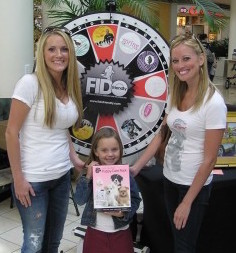 Luckily Honey is a good traveler. Susan was worried about taking a puppy on the road that wasn't house-trained, but Honey was so good from the beginning when they drove home last year. She even got in her crate and pretty much slept the whole entire time.
Luckily Honey is a good traveler. Susan was worried about taking a puppy on the road that wasn't house-trained, but Honey was so good from the beginning when they drove home last year. She even got in her crate and pretty much slept the whole entire time.
Honey is also on the road with them this year, so she's getting to go to all these different hotels and give her paws up on these different hotels that they stay at along the way.
Here are the upcoming dates for the tour:
September 23
Edmond, Oklahoma
Event held noon-4
Lawton Animal Welfare
Edmond, OK
September 24
Tulsa, Oklahoma
Event held noon-4
Woodland Hills Mall
7021 S. Memorial Drive
Tulsa, OK
September 26
Joplin, Missouri
Event held noon-4
Golden Paw Rescue
2301 N Main St.
Joplin, MO
September 28
Springfield, Missouri
Event held noon-4
Petco
3840 W. Washita
Springfield, MO
October 1
St. Louis, Missouri
Event held 10-3
Tiles Park
K-9 Carnival
9551 Litzinger Rd.
St. Louis, MO
October 7
Chicago, Illinois
Event held noon-4
Paws Chicago
1997 N. Clybourn Ave.
Chicago, IL
October 8
Springfield, Illinois
Event held noon-4
Schell's Sporting Goods
3810 S. MacArthur Blvd.
Springfield, IL
October 14
Grandview, Missouri
Event held 2-6
Petco
12124 15th St.
Grandview, MO
October 15
Merriam, Kansas
Event held noon-4
Great Plains SPCA
5428 Antioch Dr.
Merriam, KS
Be sure to come on out to one of their stops along the way. Who knows, you may find your forever pet! And if not, come on out to support your local shelter.
Visit Website
How to NOT Train a Dog - Dr. Debbie
 The other day I was walking my dog in a community area and encountered a lady with two Shih Tzus. As we approached, her dogs rallied with barking and tugging on their leashes. I asked if her dogs were friendly, so as to decide if we could approach. The lady scowled, embraced her still barking dogs and grumbled, "Do they look like they're friendly?"
The other day I was walking my dog in a community area and encountered a lady with two Shih Tzus. As we approached, her dogs rallied with barking and tugging on their leashes. I asked if her dogs were friendly, so as to decide if we could approach. The lady scowled, embraced her still barking dogs and grumbled, "Do they look like they're friendly?"
Realizing this dog owner was more unsociable than her dogs, I decided to vamoose, but not before I envisioned this blog topic - how pet owners mold unsocial dog behavior.
Unwanted doggie behavior such as lunging and barking on the leash become established when the dog owner hasn't made it clear what the appropriate behavior is, fails to correct and redirect to a more suitable behavior, or simply reinforces the undesirable behavior through actions or words. Face it - there aren't bad dogs, just poorly trained ones.
Avoid making these top 5 training mistakes:
1. Secluding Your Dog in the Backyard
Keeping your dog in lock down almost guarantees problem behaviors will develop such as biting, inter-dog aggression and phobias to anything from noises to car travel. Isolated dogs lack the experience and confidence when faced with novel situations while socialized dogs adapt easily.
I see it all the time - the dog owner prides herself in keeping her dog safe. "I didn't want Fido to catch any diseases as a pup, so I didn't let him out of our backyard till he was a year old." The overwhelming fear of infectious diseases like parvovirus causes some well-meaning owners to confine their new dog or puppy to the limits of house and yard. Even more extreme is never allowing a puppy to step foot outside until after their last puppy vaccinations! Puppies are most adaptable to new experiences between 6 and 16 weeks - this is the time to expose them to unfamiliar places, people and animals.
That doesn't mean you should take your eight week old puppy to dog parks, but rather to use good sense selecting low dog traffic areas and visiting with family and friends outside of the home that have properly vaccinated pets.
2. Skipping Obedience Training
Going to school is a must for any new dog to a home, whether a puppy or adult. No two dogs are the same, and each learns differently. Formal obedience training is a useful tool to gently reaffirm who's in charge and sets the rules in the house. Statistics show that dogs that go through formal obedience training are less apt to develop behavior problems and be relinquished to shelters.
 3. Reinforcing Fear at the Veterinary Office
3. Reinforcing Fear at the Veterinary Office
In the exam room I cringe when I see a dog owner comforting a nervous, fearful or aggressive pet. That "good boy" and pat on the head reinforces your dog's behavior, making it more likely that on the next hospital visits he'll behave the same, or worse. Some problem behaviors escalate making it difficult for the veterinary staff to examine or treat the animal. This may mean additional costs for sedation or anesthesia for routine medical needs.
It's natural for a pet owner to want to reassure a pet when he is frightened and it can be difficult to hold back the urge to soothe him. However, the best strategy is to ignore those fearful behaviors in the vet office. Don't be tempted to kiss, snuggle or hold Fido on your lap when he is misbehaving. Rather, place the dog on the floor, refocus your dog's attention to you, and cue him to "sit" or "lie down."
4. Not Using Food as a Reward
Food shouldn't just be for the taking. Don't leave food out for your dog to graze whenever he wants and don't give treats just for the sake of giving a treat. Present food and treats as a reward for good behavior such as sitting quietly, going to a pillow, or performing a trick or obedience work. This places you at the top of the household hierarchy. You become the provider of great edibles in the house, and your dog will be motivated to listen to your requests in other situations.
We all love to spoil our dogs and give treats at times. But be sure to give treats for a reason, or you will have a spoiled doggie brat on your hands.
5. Not Exercising Your Pet Enough
Inadequate exercise can result in obesity and boredom, and may lead to problem behaviors like separation anxiety, destructive chewing and excessive barking. Dogs should get 30 to 60 minutes of sustained physical activity each day for optimum mental and physical benefit. And no - letting Buffy run around the backyard during the day is not adequate exercise.
Not all breeds are cut out for all exercise - a Labrador may enjoy retrieving games or swimming, a Jack Russell terrier may thrive with jogging or Frisbee, while a Basset hound will be satisfied with a leash walk.
Your dog can't be a well-adjusted, socialized canine citizen without you, as the pet owner, taking an active role in training. Put the time in, and you'll be thanked many times over with an outgoing, friendly canine pal that can accompany you on life's adventures.
Featured veterinarian known as "Dr. Debbie" on national pet radio program, Animal Radio. Ebook author of "Yorkshire Terriers: How to Be Your Dog's Best Friend"; "Pugs: How to Be Your Dog's Best Friend"; "Mini Schnauzers: How to Be Your Dog's Best Friend"; and "Shih Tzu: How to Be Your Dog's Best Friend."
Visit Website
Animal Radio News - Lori Brooks
 Keep Your Pets Away From Your Pot
Keep Your Pets Away From Your Pot
If you or you know anyone who uses marijuana, you have to store it in a safe place where pets can't get to it. There's a new study out of Colorado that shows a four-fold increase in pet cannabis-related medical cases and much of that is a simply pet getting into their owners' stash. Answer.com (a web site that allows people to chat online with experts) says that the number of questions it has received related to marijuana and pets has gone up by 65-percent. In California alone, the questions from January through July of this year increased by 73-percent. In reviewing their calls, Ask.com said most of the requests for information asked about what to do if a dog or cat had consumed marijuana, with most of those cases involving dogs. There's a chemical naturally in marijuana called THC (it's what gives users the high) that is toxic to pets. Veterinary experts say that cannabis can damage the neurological system in pets and can sometimes be fatal. They fear they are just seeing the start of the problems. But not all of these pet overdose cases are accidental ingestion. They're starting to see an increase in cannabis intoxications due to pet parents using 'low THC' cannabinoid or CBD products. The market is booming for so-called "pot for pets" products, many made from hemp, because it contains only minute traces of THC and purportedly can treat certain pet ailments. These products boast of the benefits of CBD (cannabidiol), a cannabis compound that doesn't include any of the intoxicating qualities. There's big difference and if you're not familiar with cannabis and all of it's components, have a talk with your vet before giving any pot pet products to your fur babies. Finally, experts warn about the poop of humans who eat cannabis foods and deserts, because dogs have been known to eat human poop. Just so you know, consumed cannabis is not metabolized in humans as it passes through the digestive system and is expelled in the feces. If a dog eats that poop, it's the same as them ingesting it. Also, many of the marijuana desserts and sweets are made using xylitol and artificial sweeter which is extremely toxic to dogs.
 A Real Catfight
A Real Catfight
There's a potential catfight brewing in Britain because his rival Palmerston is threatening the British government's longtime mouse-hunting cat Larry's position. The Foreign Office cat Palmerston is putting pressure on Downing Street's resident mouser, Larry, after a document released under Freedom of Information laws said Larry had killed at least 27 mice since coming to the office last year. However, Palmerston's care takers in the Foreign Office boast that Palmerston's count is likely much higher than Larry's 27 and are quick to point out that Larry was recently involved in a controversy after he was caught sparing a mouse's life.
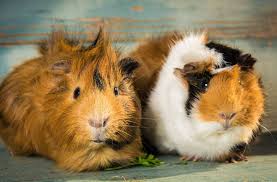 You Can Get Pneumonia from Guinea Pigs
You Can Get Pneumonia from Guinea Pigs
There's a new discovery that's just hit the world of guinea pig lovers. Dutch researchers say the cute furry rodents may carry germs tied to a very serious type of pneumonia. It's caused by the same bacteria the causes pink eye in guinea pigs and three people in the Netherlands have wound up hospitalized for pneumonia after contact with guinea pigs. Two of the three patients had to be put on a ventilator in intensive care units, or ICUs, although all three survived following treatment with antibiotics. Experts say it was not previously known that the bacteria could infect humans. Not all guinea pigs carry this bacterium, but many likely do. An earlier study found the bacteria's DNA in 59 out of 123 guinea pigs with eye disease and pink eye. Whether your guinea pig has pink eye or not, it's very important that you practice good personal and pet hygiene and wash your hands every time after handling the pet just in case your guinea has that bacteria. And never let anyone who is immune compromised or very young children handle guineas with eye infections.
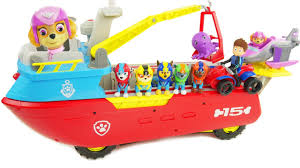 Hot Christmas Toys For Pet Loving Kids
Hot Christmas Toys For Pet Loving Kids
This may be too early for some people, but there are a couple of great gifts for animal loving children on this year's Holiday Hot Toys List from Toys R Us. If you know a child who loves PAW Patrol, the PAW Patrol Sea Patroller toy set makes the list, as does Hatchimals Surprise, though that will not be available until next month. The Furreal Roarin' Ivory Tiger also makes the list although it won't be available until November at a cost of around $130.
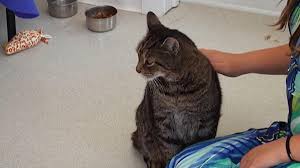 Missing Cat Is Reunited With Family After 10 Years
Missing Cat Is Reunited With Family After 10 Years
Pets seem to go missing all the time, but it's not every day that they are reunited with their families. Jack the cat and his family were incredibly lucky! Ten years ago Jack went missing but because Jack had been micro-chipped as a kitten the Sanctuary where Jack eventually ended up was able to find his family after all that time.
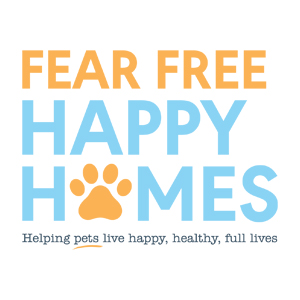
NEWS UPDATE brought to you by Fear Free. "Take the 'pet' out of 'petrified'" and get pets back for veterinary visits by promoting considerate approach and gentle control techniques used in calming environments.
 Listen to the entire Podcast of this show (#929)
Listen to the entire Podcast of this show (#929)



 Licensed Veterinary Tech and Certified Professional Dog Trainer Debbie Martin is here to help us decode our pet's body language. She knows just about everything about dog behavior and how to read your own dog's body language and states there are some common signs of distress or anxiety that people miss. This is part of our Fear Free Expert Series.
Licensed Veterinary Tech and Certified Professional Dog Trainer Debbie Martin is here to help us decode our pet's body language. She knows just about everything about dog behavior and how to read your own dog's body language and states there are some common signs of distress or anxiety that people miss. This is part of our Fear Free Expert Series. What are some common signs of distress and anxiety?
What are some common signs of distress and anxiety? When you put your hand out, in dog language that is getting into their personal space maybe before they're ready. Debbie's biggest tip for people is to play hard to get even with dogs that seem interested in you. Act very nonchalant. Avoid eye contact. Turn sideways and let them approach you on their own terms instead of trying to be their friend right away. Because even the most well intentioned friendly person can put a dog off very quickly by getting into their face and trying to be their best friend immediately.
When you put your hand out, in dog language that is getting into their personal space maybe before they're ready. Debbie's biggest tip for people is to play hard to get even with dogs that seem interested in you. Act very nonchalant. Avoid eye contact. Turn sideways and let them approach you on their own terms instead of trying to be their friend right away. Because even the most well intentioned friendly person can put a dog off very quickly by getting into their face and trying to be their best friend immediately.  Animal Planet host Travis Brorsen begins a four-month weight loss and behavior modification journey with pet owners and their overweight animals. Is your pet tipping the scale? Don't take it personally. Over 60-percent of American pets are obese.
Animal Planet host Travis Brorsen begins a four-month weight loss and behavior modification journey with pet owners and their overweight animals. Is your pet tipping the scale? Don't take it personally. Over 60-percent of American pets are obese.  You can make a lot of small changes to help your pet lose weight, but you need to be able to stick with it and make it a routine. Just like human diets, we diet for a few weeks and then we fall back into our old habits. It's really about making a whole lifestyle change.
You can make a lot of small changes to help your pet lose weight, but you need to be able to stick with it and make it a routine. Just like human diets, we diet for a few weeks and then we fall back into our old habits. It's really about making a whole lifestyle change.  The show put together a complete health and wellness plan everything from daily exercise to the amount of food they should be feeding their pet when they should be feeding their pet for the contestants.
The show put together a complete health and wellness plan everything from daily exercise to the amount of food they should be feeding their pet when they should be feeding their pet for the contestants. It's time again for the Ninth Annual Get Your Licks on Route 66 Adoption Tour. Miss Susan Sims is checking in from the road.
It's time again for the Ninth Annual Get Your Licks on Route 66 Adoption Tour. Miss Susan Sims is checking in from the road.  Luckily Honey is a good traveler. Susan was worried about taking a puppy on the road that wasn't house-trained, but Honey was so good from the beginning when they drove home last year. She even got in her crate and pretty much slept the whole entire time.
Luckily Honey is a good traveler. Susan was worried about taking a puppy on the road that wasn't house-trained, but Honey was so good from the beginning when they drove home last year. She even got in her crate and pretty much slept the whole entire time.  The other day I was walking my dog in a community area and encountered a lady with two Shih Tzus. As we approached, her dogs rallied with barking and tugging on their leashes. I asked if her dogs were friendly, so as to decide if we could approach. The lady scowled, embraced her still barking dogs and grumbled, "Do they look like they're friendly?"
The other day I was walking my dog in a community area and encountered a lady with two Shih Tzus. As we approached, her dogs rallied with barking and tugging on their leashes. I asked if her dogs were friendly, so as to decide if we could approach. The lady scowled, embraced her still barking dogs and grumbled, "Do they look like they're friendly?" 3. Reinforcing Fear at the Veterinary Office
3. Reinforcing Fear at the Veterinary Office
 Keep Your Pets Away From Your Pot
Keep Your Pets Away From Your Pot
 A Real Catfight
A Real Catfight
 You Can Get Pneumonia from Guinea Pigs
You Can Get Pneumonia from Guinea Pigs
